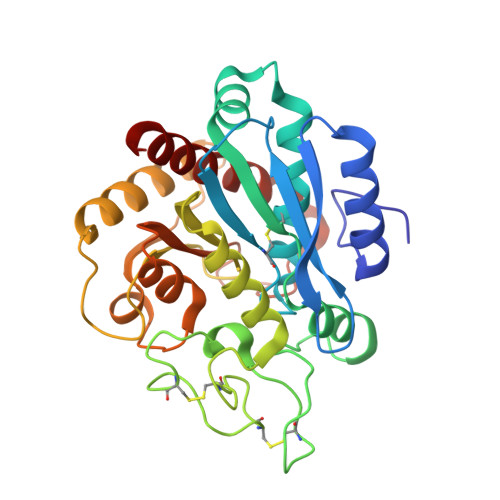Crystal structures of potent thiol-based inhibitors bound to carboxypeptidase b.
Adler, M., Bryant, J., Buckman, B., Islam, I., Larsen, B., Finster, S., Kent, L., May, K., Mohan, R., Yuan, S., Whitlow, M.(2005) Biochemistry 44: 9339-9347
- PubMed: 15982000
- DOI: https://doi.org/10.1021/bi0501941
- Primary Citation of Related Structures:
1Z5R, 1ZG7, 1ZG8, 1ZG9 - PubMed Abstract:
This paper presents the crystal structure of porcine pancreatic carboxypeptidase B (pp-CpB) in complex with a variety of thiol-based inhibitors that were developed as antagonists of activated thrombin-activatable fibrinolysis inhibitor (TAFIa). Recent studies have indicated that a selective inhibitor of TAFIa could enhance the efficacy of existing thrombolytic agents for the treatment of acute myocardial infarction, one of the most prevalent forms of heart attacks. Unfortunately, activated TAFIa rapidly degrades in solution and cannot be used for crystallographic studies. In contrast, porcine pancreatic CpB is stable at room temperature and is available from commercial sources. Both pancreatic CpB and TAFIa are zinc-based exopeptidases, and the proteins share a 47% sequence identity. The homology improves considerably in the active site where nearly all of the residues are conserved. The inhibitors used in this study were designed to mimic a C-terminal arginine residue, one of the natural substrates of TAFIa. The X-ray structures show that the thiol group chelates the active site zinc, the carboxylic acid forms a salt bridge to Arg145, and the guanidine group forms two hydrogen bonds to Asp255. A meta-substituted phenyl was introduced into our inhibitors to reduce conformational freedom. This modification vastly improved the selectivity of compounds against other exopeptidases that cleave basic residues. Comparisons between structures indicate that selectivity derives from the interaction between the guanidine group in the inhibitors and an acidic active site residue. The location of this acidic residue is not conserved in the various carboxypeptidases.
Organizational Affiliation:
Berlex Biosciences, 2600 Hilltop Drive, P.O. Box 4099, Richmond, California 94804-0099, USA.
















